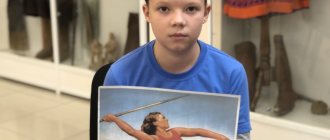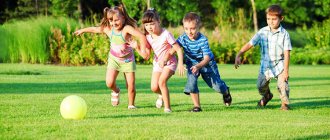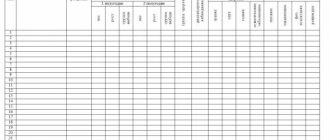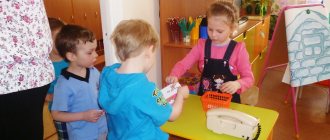"Protection and promotion of children's health"
Author: Pastorok Maria Anatolyevna
Protecting and promoting children's health is one of the main tasks facing kindergartens and families. Teachers introduce parents to the daily routine in a preschool institution and give recommendations on organizing the daily routine in the family. The daily routine affects the physical development and health of the baby. It is necessary to continue working in the family to develop self-care skills in children. Teachers recommend effective methods that are appropriate to the age of children: demonstration, explanation, personal example of loved ones, encouragement to imitate, use of play techniques. In conversations with parents, educators emphasize the need for them to maintain constant restraint, patience, and respect for the child’s personality. The teacher recommends that each family create the conditions necessary for the child’s full development and upbringing, purchase a table and chair according to the child’s height, allocate a place for games and activities, and identify a beautiful hanger for outerwear. In a conversation with parents, the teacher gives advice on the order in which the child should put on and take off clothes, how to behave at the table, how to hold a spoon, etc. Among the children there are those who suffer from poor appetite, you should consult a pediatrician. You cannot entertain children with toys or reading while eating; It is impossible to teach a child to eat a lot of sweets from an early age, they weaken the immune system, the body’s resistance to disease, and diabetes may develop.
It is necessary to invite parents to the kindergarten to observe the children during breakfast, lunch, dressing, etc. This should be done in the first days of visiting the kindergarten in order to facilitate the child’s adaptation period, which is often accompanied by the child’s illness. The teacher advises taking children home earlier than expected to give them the opportunity to get used to new living conditions; you can bring your favorite toy or book with you to kindergarten.
Lack of awareness of parents in matters of child health can be the cause of his frequent illnesses. Therefore, individual work with each family is necessary. Excessive overheating of babies is harmful. Full walks depend on how children are dressed. The teacher pays attention to this and gives advice. Children should move, walk, run and play outdoor games. The teacher draws the family's attention to the organization of the child's sleep: what time does he go to bed in the evening, how long does he sleep, is the TV on, etc. Lack of sleep leads to the development of childhood neurosis. You can allow the child to take a soft toy with him to bed, the touch of which causes a state of peace, warmth, and encourages sleep, but do not allow the child to play in bed. It is unacceptable for parents to smoke in the room where the child is.
The family has great opportunities for the moral education of younger preschoolers. It’s not too early to present them with moral standards and teach them rules of behavior. For many parents, the basis for raising children at this age are taboos: “don’t touch,” “don’t get dirty,” “you can’t,” etc. The teacher introduces parents to the tasks of moral education of children, which are important to solve in community.
Moral education must begin from an early age, when behavioral habits are easy to form: be polite, get used to being busy, respect elders, show care, learn the norms of communication, speech, facial expressions, gestures, respect the work of others, be kind to the adult children around you. Teachers advise parents with one child in the family to invite home friends from kindergarten or neighbors to play. Parents should not yell at the child, they should talk calmly, say good night, good morning, and thank them for their help.
Educators attract parents to kindergarten to prepare for the holidays. The joint work of the kindergarten and the family makes it possible to optimally solve the problems of the harmonious development of children.
Daily regime. A single daily routine is recommended for all children in the third year of life. At the same time, it is necessary to ensure, throughout the entire period of active wakefulness, a rational alternation of various types of activities, including an appropriate amount of mental, physical and emotional stress for the children’s age, as well as proper rest. It is carried out depending on the health status of each child, especially his nervous system and level of development. When developing self-care skills in children, they should be provided with constant assistance. When accepting a child to kindergarten, the teacher asks parents about his well-being and behavioral characteristics. If a disease is suspected, it is necessary to provide the child with a medical examination.
Catering. The main requirement is strict regularity and timeliness - the basis for a good appetite in a child. Prepared food is delivered in a special, labeled, sealed container. The nanny thoroughly washes her hands with soap, puts on a clean robe and scarf, and washes the tables with hot water and soap. The teacher makes sure that children wash their hands with soap and wipe them dry. Meals should always take place in a calm environment.
Organization of sleep. Before children go to bed, the room is well ventilated; depending on the weather, the windows are left open during sleep; during sleep, there should be silence in the room; loud conversations, screams, and noisy outdoor games are unacceptable; It is important for children to have pajamas and cotton shirts.
Organization of a walk. Games and nature observations are organized on the site. It is important that children do not become overheated or cooled down. Children's play activities during a walk should be under the control and guidance of a teacher.
Organization of classes. The correct organization of educational activities with children of primary preschool age provides for a playful form, extensive use of visual material, and motor aspects that contribute to the most effective development of children and prevent fatigue.
Classes should be interesting in content and varied in structure, taking into account the age characteristics of children.
Hardening. Aimed at improving the body's defense reactions, increasing resistance to diseases and resistance to temperature fluctuations. An effective form of air hardening is a walk in the morning, when children are exposed to ultraviolet radiation. Healthy children are hardened by the sun during games in a zone of light and shade and diffused sunlight. Children are gradually introduced to water procedures, starting with local douches and wet rubdowns. First, they teach you to wash your face, wash your hands (up to the elbow, your neck with water at room temperature. Then they move on to special procedures. Dousing the feet is carried out after a day's sleep (temperature not lower than 20 degrees). General douching (showering) in the warm period of the year is required after a walk, then hardening acts as a hygienic procedure.
Depending on the health status of the children and in consultation with the doctor, you can start swimming in open reservoirs, where the water depth is up to the child’s waist and the bottom is clean and level.
Swimming is carried out under the supervision of two adults: one in the water with children, the other on the shore. Children should move and play in the water. Cooling should not be allowed. In this case, the child is taken out of the water, rubbed with a towel until the skin turns pink and changed into dry underwear. If children have been in an area illuminated by direct sunlight for a long time, swimming should not be done immediately.
A game.
Story-based role-playing games. The teacher, in a joint game with the child, teaches him the simplest play actions, how to feed a doll or a bear, rock them, put them to bed. For games, you should select simple plots with one or two characters and basic actions: the driver loads the car with cubes and drives it, the mother pushes her daughter in a stroller and feeds her. The teacher comes up with stories himself or uses literary texts: short stories, poems. For example, “It’s time to sleep, the bull fell asleep and lay down in his crib on his side”, “The sleepy bear lay down in bed, but the elephant doesn’t want to sleep”, “Both the doll and the bunny also want to sleep” comments powered by HyperComments
Organization of work in preschool educational institutions to protect the life and health of children article on the topic
Organization of life protection work in preschool educational institutions
and children's health
A preschool educational institution provides education, training, supervision, care and health improvement for children. But the main task of preschool educational institutions is to protect the lives and strengthen the health of children.
According to Article 41 of the Federal Law of December 29, 2012 No. 273-FZ “On Education in the Russian Federation,” student health protection includes:
1) provision of primary health care in the manner established by legislation in the field of health care;
2) organizing meals for students;
3) determination of the optimal academic and extracurricular load, study schedule and duration of vacations;
4) promotion and training in healthy lifestyle skills and occupational safety requirements;
5) organization and creation of conditions for the prevention of diseases and health improvement of students, for them to engage in physical education and sports;
6) students undergo medical examinations in accordance with the legislation of the Russian Federation, including preventive medical examinations, in connection with physical education and sports, and medical examinations;
7) ensuring the safety of students during their stay in an organization carrying out educational activities;
 prevention of accidents with students during their stay in an organization carrying out educational activities;
prevention of accidents with students during their stay in an organization carrying out educational activities;
9) carrying out sanitary, anti-epidemic and preventive measures;
10) training teaching staff in first aid skills.
The activities of a preschool educational institution are aimed, first of all, at creating, providing and maintaining comfortable working conditions for employees and the stay of pupils, as well as ensuring the intellectual, personal and physical development of the child.
Comfort is a characteristic of the conditions of teaching activity in a preschool educational institution, reflecting the favorableness of the environment for the psychophysiological state of pupils and their successful training and education.
The main components of a comfortable learning environment are:
— sanitary and hygienic conditions;
— provision of the pedagogical process with teaching aids and equipment;
— aesthetic comfort of the environment (design);
- psychological comfort.
Sanitary and hygienic conditions are assessed according to the following indicators:
— ambient temperature;
- air humidity;
— air speed;
— illumination;
- norm of premises area, territory per pupil.
The provision of the pedagogical process is characterized by the following indicators:
— availability of benefits (educational, gaming, recreational);
— availability and condition of gaming and educational equipment;
— physiological validity of the regime of classes, rest, physical education;
— load intensity;
— form of organization of classes (group, individual), structure of classes;
— the ability to choose forms of activity.
The aesthetic comfort of the environment (design) is assessed by the quality of the design of group rooms, music and sports halls, staircases and other spaces.
Psychological comfort is a state of calm in which workers perform their functions and children remain in kindergarten. A state of psychological comfort is achieved when all necessary organizational measures are carried out in the preschool educational institution, such as monitoring the state of working conditions and labor protection, monitoring the implementation of sanitary requirements, analyzing the results of work on labor protection, analyzing injuries, maintaining established documents on labor protection .
The requirements for protecting the life and health of children in a preschool educational institution must be met around the clock:
- Once a quarter, the labor safety commission draws up inspection reports for playgrounds, other premises for working with children, barriers, etc., and daily monitoring is carried out by responsible persons in order to timely eliminate causes that pose a threat to the life and health of pupils and workers. Comfort will be achieved when performing all of the above activities if:
— buildings and structures are in proper condition, which is confirmed by the relevant executive documents;
— there is, in accordance with supply standards, production and educational equipment;
- preschool educational institutions employees undergo training on protecting the life and health of pupils (a record of the training is regularly entered into the briefing log at the workplace, with the obligatory signature of the person being instructed and the person instructing. Moreover, the instruction can be carried out both according to the plan and outside the plan (for example, during training for the summer health period in a preschool educational institution, in case of an emergency, etc.);
- Activities are systematically carried out with students in accordance with the annual work plan to prevent child road traffic injuries, teachers talk about safety on water and ice, actions in case of fire or situations in which the child is left at home alone, etc.;
- safety months are organized in preschool educational institutions, work on the prevention of children's road traffic injuries is analyzed;
- all groups require “, which contains information for parents about childhood diseases, measures to prevent them, preventive measures for children’s road traffic and household injuries;
- issues of ensuring the safety of all participants in the educational process are considered monthly at a meeting of teaching staff, at an administrative meeting with the head, and at general meetings of the workforce. As part of such events, regulatory documentation and instructional and methodological materials on the issues of protecting the life and health of children are studied.
All this, in turn, allows us to maintain high performance of the team, develop children, carry out the necessary correction of deviations in child development, maintain and improve their health, and prevent injuries in adults and children.
Coordination network for monitoring security work
life and health of preschool children
| № | Controlled material | Determined control indicators | Frequency of control | Responsible | ||
| 1. Premises of the kindergarten associated with the stay of children | ||||||
| 1.1 | Playrooms, bedrooms, toilets, locker rooms, sports and music rooms, teaching and medical offices | Air temperature | 1 time per week | Art. nurse | ||
| Relative humidity | 1 time per quarter | Art. nurse | ||||
| Artificial lighting level | 1 time per year | Art. nurse | ||||
| Ventilation mode | 1 time per month | Art. nurse | ||||
| 1.2 | Furniture for playrooms and bedrooms | Marking and matching the child's height and furniture arrangement | 2 times per year | Art. nurse | ||
| 1 time per week | Art. nurse | |||||
| 1.3 | Bed linen, baby care items | Individual marking | Once a month, linen - with each change | Art. nurse | ||
| 1.4 | Gym and utility room attached to it | Availability of protective devices to prevent injury | 2 times per year | Deputy head according to ACh | ||
| Availability of sportswear for children during classes | 1 time per month | Deputy head according to UVR | ||||
| Arrangement and technical serviceability of sports equipment | 1 time per week | Deputy head according to ACh | ||||
| 1.5 | Sanitary maintenance of premises | Compliance with the frequency of general cleaning and its quality | 1 time per quarter | Art. nurse | ||
| Quality of current cleaning | 1 time per month | Art. nurse | ||||
| The state of availability of cleaning equipment, detergents and disinfectants and the conditions for their storage | 1 time per month | Art. nurse | ||||
| Availability of separation of cleaning equipment by purpose and its marking | 1 time per month | Art. nurse | ||||
| Availability, condition and marking of containers for soaking dishes in case of quarantine or transportation of dirty linen | 2 times a month | Art. nurse | ||||
| 2. Kindergarten territory | ||||||
| 2.1 | Yard | Serviceability of the fence | 2 times per year | Deputy head according to ACh | ||
| Serviceability of artificial lighting | 1 time per year | Deputy head according to ACh | ||||
| Serviceability and condition of the garbage disposal and trash cans | 1 time per quarter | Deputy head according to ACh | ||||
| 2.2 | Play areas | State of small forms | 2 times per year | Deputy head according to ACh | ||
| Availability of sand for playing | 2 times per year | Deputy head according to ACh | ||||
| Sand processing | 1 time per week | Art. nurse | ||||
| Sanitary content | Daily | Art. nurse | ||||
| Absence of traumatic objects | Daily | Deputy head according to ACh | ||||
| 3. Organization of the educational process | ||||||
| 3.1 | Activities with children | Study load study: — compliance with the maximum allowable amount of study time per day and per week; - duration of classes and breaks between them; — availability of a separate schedule for additional classes included in the maximum permissible load; — the presence of health-saving moments during classes; — feasibility of using physical education minutes | 2 times per year 1 time per month 2 times per year 1 time per month 1 time per month | Head of Det. garden, Art. nurse, deputy head according to UVR | ||
| Class schedule assessment: — the presence of alternating classes with varying degrees of difficulty throughout the day and week | 1 time per quarter | Head of Det. garden, Art. nurse | ||||
| Availability of entertainment and holidays in terms of teachers’ work | 1 time per quarter | Deputy head according to UVR | ||||
| Planning educational work with children in groups | 1 time per quarter | Head of Det. garden, deputy head according to UVR | ||||
| Conditions for the use of technical training aids, compliance with the rules for placing TSO, compliance with the duration of classes with TSO | 1 time per month | Head of Det. garden, Art. nurse, deputy head according to UVR | ||||
| Assessment of pedagogical diagnostics of children’s assimilation of program material | 2 times per year | Head of Det. garden, deputy head according to UVR | ||||
| Assessment of the composition of the motor regime of children by age groups, its compliance | 2 times per year | Head of Det. garden, deputy head according to UVR | ||||
| Organization and duration of walks with children | 1 time per week | Head of Det. garden, deputy head according to UVR | ||||
| 4. Organization of children's meals | ||||||
| 4.1 | Diet | Qualitative and quantitative composition of the diet, its compliance with age and physiological needs; compliance with the requirements and recommendations for the formation of a diet; range of products used in nutrition | 1 time every 10 days | Head of Det. garden, Art. nurse | ||
| 4.2 | Diet | Compliance of diet and eating conditions with age and hygiene requirements | 1 time per week | Head of Det. garden, Art. nurse | ||
| 4.3 | Documentation on sanitation, hygiene, food production technology, rejection results, daily medical examinations of food department workers | Completeness, accuracy and timeliness of registration (maintenance) of documentation, compliance with the requirements of sanitary rules, norms and hygienic standards | 1 time per quarter | Head of Det. garden, Art. nurse | ||
| 4.4 | Food production technology | Correct execution of technological documentation. Availability of necessary regulatory and technical documentation | 2 times per year | Head of Det. garden, Art. nurse | ||
| Compliance with sanitary and technological requirements during food production | 1 time every 10 days | Head of Det. garden, Art. nurse | ||||
| Temperature inside heating equipment | 1 time per week | Head of Det. garden, Art. nurse | ||||
| 4.5 | Process flow | The presence (absence) of common counter, intersecting flows of raw and finished products, clean and dirty dishes, equipment, containers, etc. | 1 time per week | Head of Det. garden, Art. nurse | ||
| 4.6 | Dinnerware | Quality of dishwashing, its labeling | 1 time per month | Art. nurse | ||
| 4.7 | Products | Terms and conditions of injury. The serviceability of refrigeration equipment and the correct temperature setting in refrigerated cabinets. Neighborhood food storage | 1 time per week | Head of Det. garden, Art. nurse | ||
| 4.8 | Sales of products and finished products | Implementation deadlines, implementation conditions. Compliance with temperature requirements for prepared food. Shelf life in the catering unit of products prepared for culinary processing and ready-made food | Daily | Head of Det. garden, Art. nurse | ||
| 4.9 | Sanitary and anti-epidemic regime | Compliance with the sanitary and anti-epidemic regime in production, processing, storage and use. Markings of equipment, utensils, equipment, cleaning equipment, cleaning regime, disinfection regime, waste collection, storage and removal regime, etc. | 1 time per month | Head of Det. garden, Art. nurse | ||
| 4.10 | Personnel involved in child nutrition | State of inspection of personnel for the presence of colds and pustular diseases, survey for the presence of intestinal infections | 1 time per week | Art. nurse | ||
| Compliance with personal hygiene rules by food service workers | Constantly | Art. nurse | ||||
| Availability and timeliness of medical examinations, vaccinations, hygienic certification | 1 time per quarter | Art. nurse | ||||
| 4.11 | Sanitary condition of premises | Maintaining cleanliness during general cleaning | Once every two months | Head of Det. garden, Art. nurse | ||
| Availability of cleaning equipment, detergents and disinfectants, conditions for their storage | 1 time per month | Deputy Head of AChCh, Art. nurse | ||||
| Availability of separate cleaning equipment according to purpose and its marking | 1 time per month | Art. nurse | ||||
| 5. Swimming pool | ||||||
| 5.1 | Swimming pool bath water | Water temperature | Before starting work, selectively on one of the days of the week | Art. nurse | ||
| 5.2 | Air in the swimming pool bath room | Relative humidity, mobility | 1 time per quarter | Art. nurse | ||
| 5.3 | Sanitary condition of the pool premises | Compliance with hygienic requirements for the operation of swimming pools | 1 time per month | Art. nurse | ||
| Availability of rules and schedule for pool cleaning, their implementation | Once a month (selectively on one day) | Art. nurse | ||||
| 5.4 | Main and auxiliary premises of the pool | Efficiency of supply and exhaust ventilation, air temperature and humidity | 1 time per week | Deputy Head of AChCh, Art. nurse | ||
| 6. Staff | ||||||
| 6.1 | All kindergarten workers | Availability of health certificates for all workers in the institution with the results of medical examinations, timely completion of medical examinations | 1 time per quarter | Art. nurse | ||
| Timely completion of hygiene training | Once every two years | Art. nurse | ||||
| 6.2 | Teachers and support staff | Compliance with instructions to protect the life and health of children | Constantly, control once a month | Head of Det. garden, Art. nurse, deputy head according to UVR | ||
| 7. Organization and carrying out repair work | ||||||
| 7.1 | Maintenance | Availability of hygienic certificates for the finishing materials used, indicating the scope of application in children's institutions | Using | Head of Det. garden, Art. nurse | ||
| Matching the color scheme of paints for painting walls, doors, frames, equipment | When carrying out work | Head of Det. garden, Art. nurse, | ||||
| Prohibition of work in the presence of children | When carrying out work | Head of Det. garden, Art. nurse, | ||||
| Ensuring ventilation of premises after completion of repair work | If necessary | Head of Det. garden, Art. nurse, | ||||
| 8. Health work | ||||||
| 8.1 | Planning health activities with children for the school year | 1 time per year | Head of Det. garden, deputy head of water management | |||
| Carrying out prescribed health and hardening activities | 1 time per month | Head of Det. garden, deputy head of water management | ||||
| Analysis of children's morbidity | 2 times per year | Head of Det. garden, Art. nurse, deputy head according to UVR | ||||
| Analysis of kindergarten children's attendance | 1 time per month | Head of Det. garden, Art. nurse, deputy head according to UVR | ||||
| Analysis and effectiveness of health work with children | 1 time per year | Head of Det. garden, Art. nurse, deputy head according to UVR | ||||
| 8.2 | Pedagogical part | Compliance by teachers with sanitary norms and rules for preschool institutions | Throughout the year, selectively on one day of the week | Head of Det. garden, deputy head of water management | ||




